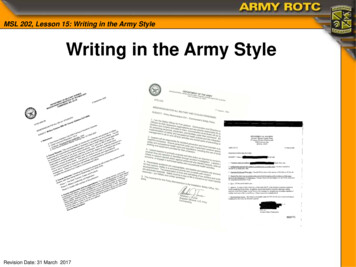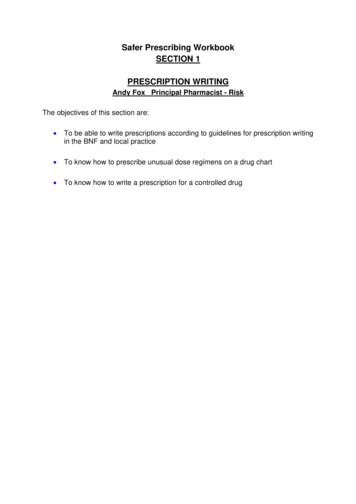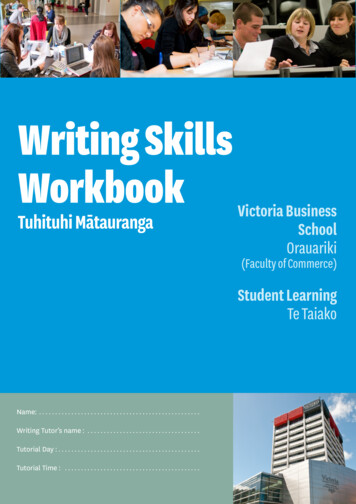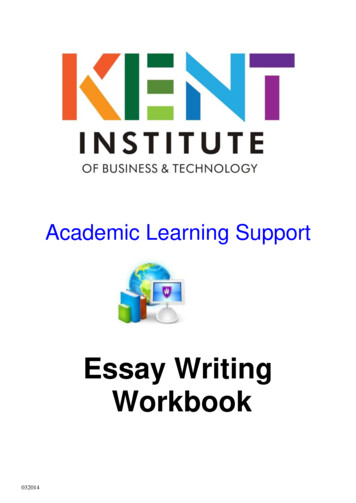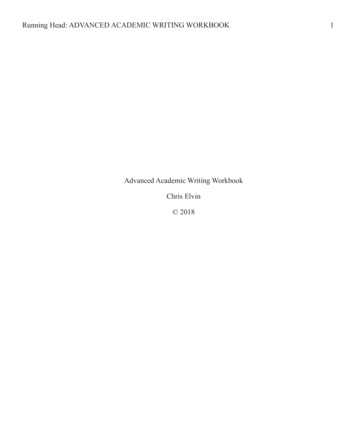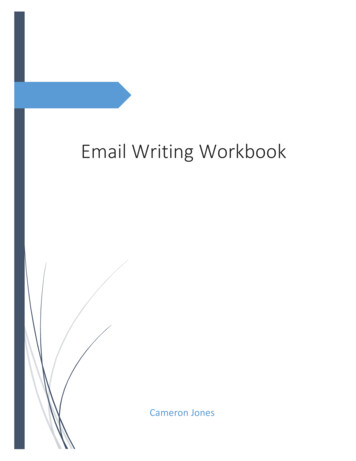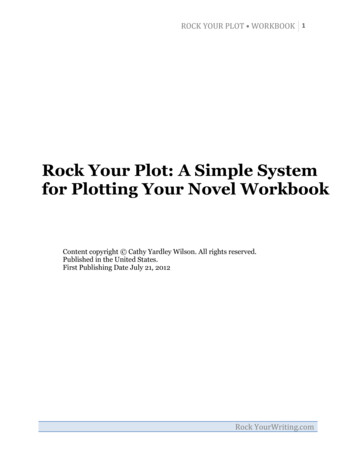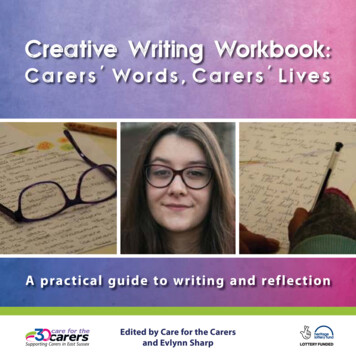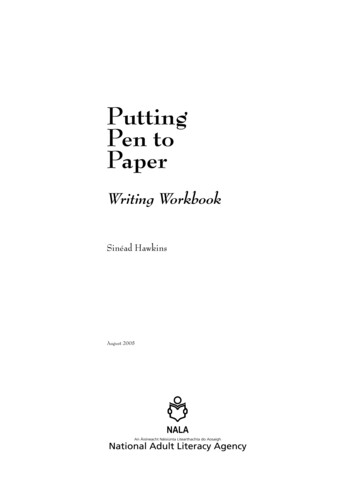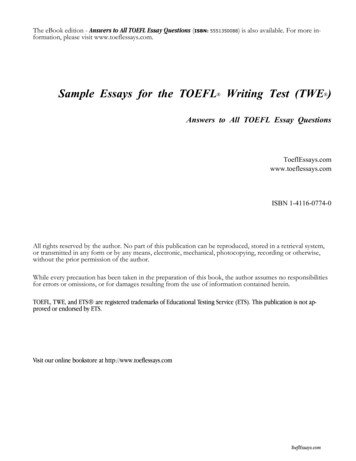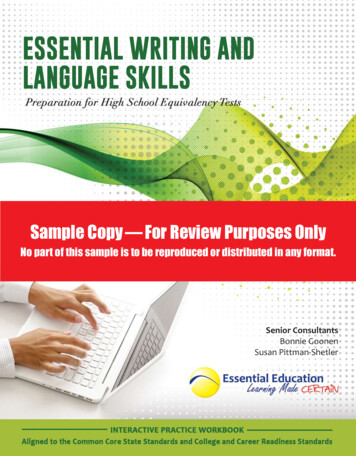
Transcription
ESSENTIALWRITINGANDLANGUAGESKILLSSample Copy — For Review Purposes OnlyNo part of this sample is to be reproduced or distributed in any etler
Essential Writing &Language SkillsInteractive Practice WorkbookAuthorsMaya MooreTeresa PerrinJenni RomanoNancy SchnogSenior ConsultantsBonnie GoonenSusan Pittman-ShetlerPublished by Essential Education0000 001-412 eLearn EssWritLang.indd 15/1/2014 8:18:24 PM
Essential Writing & Language SkillsISBN 978-1-940532-02-8Copyright 2014 by Essential Education. All rights reserved.No part of this book may be reproduced in any form or by any means, electronicor mechanical, without written permission from Essential Education, except inthe case of brief quotations embodied in critical articles and reviews.For more information, contact:Essential Education Corporation895 NW Grant AvenueCorvallis, OR 97330Phone: 800-931-8069Cover Design: Karen GuardGED is a registered trademark of the American Council on Education (ACE) andadministered exclusively by GED Testing Service LLC under license. This materialis not endorsed or approved by ACE or GED Testing Service.Essential Education provides innovative, effective HSE test preparation andadult learning programs centered on the learner’s needs.For more information, please visit http://www.passGED.com/educators/.0000 001-412 eLearn EssWritLang.indd 25/1/2014 8:18:24 PM
Table of ContentsIntroduction . . . . . . . . . . . . . . . . . . . . . . . . . . . . . . . . . . . . . . . . . . . . . . . . . . . . . . . . . . . . . . . . . . . . . . . 1The Writing Process . . . . . . . . . . . . . . . . . . . . . . . . . . . . . . . . . . . . . . . . . . . . . . . . . . . . . . . . . . . . . . . .3Plan, Draft, Evaluate . . . . . . . . . . . . . . . . . . . . . . . . . . . . . . . . . . . . . . . . . . . . . . . . . . . . . . . . . . . .5Focus: Plan . . . . . . . . . . . . . . . . . . . . . . . . . . . . . . . . . . . . . . . . . . . . . . . . . . . . . . . . . . . . . . . . . . . 13Determining Purpose and Audience . . . . . . . . . . . . . . . . . . . . . . . . . . . . . . . . . . . . . . . . . 15Reading and Thinking for Writing . . . . . . . . . . . . . . . . . . . . . . . . . . . . . . . . . . . . . . . . . . .27Choosing an Organizational Structure . . . . . . . . . . . . . . . . . . . . . . . . . . . . . . . . . . . . . . 39Focus: Draft . . . . . . . . . . . . . . . . . . . . . . . . . . . . . . . . . . . . . . . . . . . . . . . . . . . . . . . . . . . . . . . . . 47Developing a Thesis Statement . . . . . . . . . . . . . . . . . . . . . . . . . . . . . . . . . . . . . . . . . . . . 49Drafting an Introduction . . . . . . . . . . . . . . . . . . . . . . . . . . . . . . . . . . . . . . . . . . . . . . . . . . .57Drafting Body Paragraphs . . . . . . . . . . . . . . . . . . . . . . . . . . . . . . . . . . . . . . . . . . . . . . . . 65Drafting a Conclusion . . . . . . . . . . . . . . . . . . . . . . . . . . . . . . . . . . . . . . . . . . . . . . . . . . . . .73Focus: Evaluate . . . . . . . . . . . . . . . . . . . . . . . . . . . . . . . . . . . . . . . . . . . . . . . . . . . . . . . . . . . . . . .81Revising and Editing . . . . . . . . . . . . . . . . . . . . . . . . . . . . . . . . . . . . . . . . . . . . . . . . . . . . . 83Reading Critically . . . . . . . . . . . . . . . . . . . . . . . . . . . . . . . . . . . . . . . . . . . . . . . . . . . . . . . . 95Language and Word Choice . . . . . . . . . . . . . . . . . . . . . . . . . . . . . . . . . . . . . . . . . . . . . . .103Voice and Tone . . . . . . . . . . . . . . . . . . . . . . . . . . . . . . . . . . . . . . . . . . . . . . . . . . . . . . . . . . 111Unity and Cohesion . . . . . . . . . . . . . . . . . . . . . . . . . . . . . . . . . . . . . . . . . . . . . . . . . . . . . . 123Fluidity . . . . . . . . . . . . . . . . . . . . . . . . . . . . . . . . . . . . . . . . . . . . . . . . . . . . . . . . . . . . . . . . . 131Clarity . . . . . . . . . . . . . . . . . . . . . . . . . . . . . . . . . . . . . . . . . . . . . . . . . . . . . . . . . . . . . . . . . .139Focus: Submit . . . . . . . . . . . . . . . . . . . . . . . . . . . . . . . . . . . . . . . . . . . . . . . . . . . . . . . . . . . . . . .147Proofreading . . . . . . . . . . . . . . . . . . . . . . . . . . . . . . . . . . . . . . . . . . . . . . . . . . . . . . . . . . . .149Publishing . . . . . . . . . . . . . . . . . . . . . . . . . . . . . . . . . . . . . . . . . . . . . . . . . . . . . . . . . . . . . . 1570000 001-412 eLearn EssWritLang.indd 35/1/2014 8:18:24 PM
Organization . . . . . . . . . . . . . . . . . . . . . . . . . . . . . . . . . . . . . . . . . . . . . . . . . . . . . . . . . . . . . . . . . . . .165Organizing Short Answers . . . . . . . . . . . . . . . . . . . . . . . . . . . . . . . . . . . . . . . . . . . . . . . . . . . .167Organizing Extended Responses . . . . . . . . . . . . . . . . . . . . . . . . . . . . . . . . . . . . . . . . . . . . . . .179Organizing Workplace Documents . . . . . . . . . . . . . . . . . . . . . . . . . . . . . . . . . . . . . . . . . . . . . 191Developing Ideas, Arguments, and Evidence . . . . . . . . . . . . . . . . . . . . . . . . . . . . . . . . . . . . . . . 203Developing Ideas . . . . . . . . . . . . . . . . . . . . . . . . . . . . . . . . . . . . . . . . . . . . . . . . . . . . . . . . . . . 205Developing Strong Support . . . . . . . . . . . . . . . . . . . . . . . . . . . . . . . . . . . . . . . . . . . . . . . . . . . 213Evaluating Arguments . . . . . . . . . . . . . . . . . . . . . . . . . . . . . . . . . . . . . . . . . . . . . . . . . . . . . . . . 221Citing Evidence and Connecting with Claims . . . . . . . . . . . . . . . . . . . . . . . . . . . . . . . . . . . . 229Drawing Conclusions . . . . . . . . . . . . . . . . . . . . . . . . . . . . . . . . . . . . . . . . . . . . . . . . . . . . . . . . .237Issues in Revising and Editing . . . . . . . . . . . . . . . . . . . . . . . . . . . . . . . . . . . . . . . . . . . . . . . . . . . . 245Obstructions to Communication . . . . . . . . . . . . . . . . . . . . . . . . . . . . . . . . . . . . . . . . . . . . . . 247Word Usage . . . . . . . . . . . . . . . . . . . . . . . . . . . . . . . . . . . . . . . . . . . . . . . . . . . . . . . . . . . . . . . . 255Spelling, Capitalization, and Punctuation . . . . . . . . . . . . . . . . . . . . . . . . . . . . . . . . . . . . . . . 263Sentence Structure . . . . . . . . . . . . . . . . . . . . . . . . . . . . . . . . . . . . . . . . . . . . . . . . . . . . . . . . . . 271Writing Practice . . . . . . . . . . . . . . . . . . . . . . . . . . . . . . . . . . . . . . . . . . . . . . . . . . . . . . . . . . . . . . . . 279Practice in Everyday Writing . . . . . . . . . . . . . . . . . . . . . . . . . . . . . . . . . . . . . . . . . . . . . . . . . . .281Practice for Reasoning through Language Arts . . . . . . . . . . . . . . . . . . . . . . . . . . . . . . . . . 293Practice in Social Studies Writing . . . . . . . . . . . . . . . . . . . . . . . . . . . . . . . . . . . . . . . . . . . . . . 305Practice in Science Writing . . . . . . . . . . . . . . . . . . . . . . . . . . . . . . . . . . . . . . . . . . . . . . . . . . . . 317Self-Evaluation of Your Writing . . . . . . . . . . . . . . . . . . . . . . . . . . . . . . . . . . . . . . . . . . . . . . . . . . . 329Answers and Explanations . . . . . . . . . . . . . . . . . . . . . . . . . . . . . . . . . . . . . . . . . . . . . . . . . . . . . . . 333Resources . . . . . . . . . . . . . . . . . . . . . . . . . . . . . . . . . . . . . . . . . . . . . . . . . . . . . . . . . . . . . . . . . . . . . . . 4110000 001-412 eLearn EssWritLang.indd 45/1/2014 8:18:24 PM
IntroductionThe Essential Writing & Language Skills workbook will give you a foundation inplanning, drafting, and finalizing writing. Your purpose in writing will vary,from passing a standardized test to applying for a job to writing a report or paper.Good writing skills will help you succeed in all types of writing tasks. Through thisworkbook, you’ll learn to develop what you want to say and to express it clearly.After all, that’s the purpose of writing—to develop and communicate ideas.One important area of writing is analyzing and evaluating what you read. In theworkplace, you will need to not only understand reports but read them with a critical eye. Discerning the best contracting bid or product description is an essentialskill. In higher education, you will need to write original papers that reference andevaluate books, research papers, and other works. This workbook will give youpractice writing about what you read.As you practice writing, you will develop a good writing process: Plan: Read, research, brainstorm, andidentify your central idea. Draft: Outline and write a beginning, middle,and ending. Evaluate: Throughout the writing process,evaluate your work. As you evaluate, continue to plan, revise, and edit your draft. Submit: When your writing is done,proofread, format, and publish your work.A writing process will give you a structure todevelop your ideas around a strong centralidea, to make decisions about organization and10000 001-412 eLearn EssWritLang.indd 15/1/2014 8:18:25 PM
Essential Writing & Language Skillslanguage, and to edit and finalize your work. You’ll also learn about what makesgood writing, from understanding your audience’s point of view to developingtone and style.This writing book contains practice problems that involve several levels ofknowledge and thinking.If an exercise has one star, it is testing your ability to recall and use specific skills, suchas grammar and language use.If an exercise has two stars, it asks you to interpret, summarize, or do other tasks thatrequire some analysis. A two-star problem is checking to see if you have acquired a skillor concept.If an exercise has three stars, it asks you to think strategically to answer a question orrespond to a prompt. These exercises will require short or extended responses.Technology TipAs your writingimproves, practiceusing a keyboard.Set a goal to type20 to 50 wordsper minute.You can use this workbook on its own, by working through eachsection, to improve your writing skills. The practice in this workbook will reinforce the skills you already have and develop newones. You’ll learn by applying those skills to many different situations. Practice helps you improve quickly because you’re activelyusing the skills you’re learning.This workbook is also a good supplement to classroom learningor online courses, including Essential Education courses such asGED Academy and Essential Skills Online. You don’t need to gothrough the workbook in one particular order. Instead, use whatever section teaches the skills you’re currently learning. If you’re in a class, yourteacher can help you choose the best sections to study.Take your time working through the exercises in this book. They’re meant toenhance your thinking skills and to give you practice with many writing tasks sothat you can develop strong writing for any situation. If your writing speed is slow,work to increase your speed as you work through the book. Many Check Your Skillsshort answers and extended responses include target times to help you preparefor timed exams.20000 001-412 eLearn EssWritLang.indd 25/1/2014 8:18:26 PM
Plan, Draft, EvaluateConnectionsHave you ever . . . Had trouble starting a writing assignment? Written an important email to a supervisor or client? Composed a letter to your senator or representative?Writing isn’t just churning out words. To write successfully, youuse a process. Whether you are emailing a client to describe company policies, writing a New Year’s message to all your family, orcomposing a research paper for a college class, writing involvesmaking many decisions. You choose your length, topic, words, andtone. All of those decisions affect your message and your reader.Consciously following a writing process helps you make deliberate choices to writeeffectively. Use a four-step writing process to improve your writing.Plan: Examine your task. Who is the audience? What is the purpose? Research your topic, read and examine source materials,brainstorm ideas, and think through what you want to say.Draft: Prewrite and compose your work. You might start with acentral idea, some supporting ideas, and evidence or examples.Then, fill in details, connections, transitions, and conclusions.TheWritingProcessEvaluate: As you work, evaluate your writing. Is it successful? Doesit communicate? Continue to plan, revise, and edit your draft.Submit: When your work is ready, make final changes and publish.That might mean posting your work on your blog, submitting apaper to your professor, or mailing a letter to a company.SubmitUse the first three steps together. As you plan, prewrite and evaluate. Asyou draft, plan and evaluate. As you evaluate, plan, rewrite, and edit.50000 001-412 eLearn EssWritLang.indd 55/1/2014 8:18:28 PM
Essential Writing & Language SkillsLearnIt!Plan, Draft, and Evaluate Your WritingThe writing process helps you approach writing thoughtfully so you can improveyour skills. You will make conscious decisions as you plan, draft, and evaluate.Imagine you need to make a recommendation to your boss about which printer topurchase for the office. You work in a busy office that prints up to 1,000 pages perday. Examine the table and write a recommendation, including your reasoning.PricePrinter APrinter B 459 624Speed (Pagesper Minute)24 ppm28 ppmMonthlyWorkload70,000 pages50,000 pagesInk Cost (Centsper Page)4.22.3PlanFirst, examine your task. What is your purpose? Who is your audience? Is this a formalor informal task? What do you need to read and understand? What do you want to say?Strategies that help you think through writing tasks and plan your writing include: Defining purpose and audience Brainstorming ResearchingWriting doesn’t occur in a vacuum. Developing good ideas and st
Good writing skills will help you succeed in all types of writing tasks. Through this workbook, you’ll learn to develop what you want to say and to express it clearly. After all, that’s the purpose of writing—to develop and communicate ideas. One important area of writing is analyzing and evaluating what you read. In the workplace, you will need to not only understand reports but read .File Size: 2MBPage Count: 31

